PG Cooper
CS! Silver
 Join Date: Feb 2009
And those who tasted the bite of his sword named him...The DOOM Slayer
Join Date: Feb 2009
And those who tasted the bite of his sword named him...The DOOM Slayer
Posts: 16,647 
Likes: 4,062
Location:
Last Online Nov 22, 2024 22:27:20 GMT -5
|
Post by PG Cooper on Nov 26, 2015 10:00:05 GMT -5
For what it's worth I'm only going to be "cheating" on one more slot going forward.  |
|
thebtskink
CS! Silver
 Join Date: Jul 2000
It puts the lotion on its skin or else it gets the hose again.
Join Date: Jul 2000
It puts the lotion on its skin or else it gets the hose again.
Posts: 19,462 
Likes: 4,984
Location:
Last Online Nov 22, 2024 15:43:24 GMT -5
|
Post by thebtskink on Nov 26, 2015 10:57:06 GMT -5
|
|
Dracula
CS! Gold
 Join Date: Sep 2002
Join Date: Sep 2002
Posts: 26,102 
Likes: 5,731
Location:
Last Online Nov 22, 2024 23:42:21 GMT -5
|
Post by Dracula on Nov 26, 2015 20:25:46 GMT -5
50. Notorious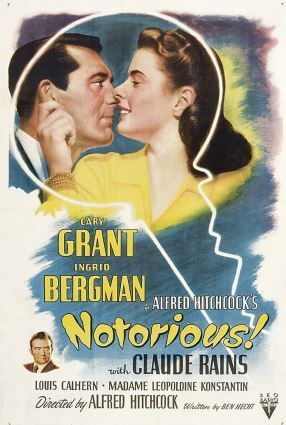 Year Year: 1946 Director: Alfred Hitchcock Writer(s): Ben Hecht Starring: Cary Grant, Ingrid Bergman, Claude Rains, and Leopoldine Konstantin Studio: RKO Radio Pictures Country of Origin: USA Language: English Running Time: 101 Minutes Aspect Ratio: 1.37:1 Notorious is not one of Alfred Hitchcock’s most famous movies with the general public in part because it doesn’t have the high concept of something like Rear Window or the shock moments of something like Psycho or the action set-pieces of something like North By Northwest. Instead the movie has really earned its reputation among the critics and film lovers who have dug a bit deeper into Hitchcock’s work. Truth be told, while there are some tense moments the movie is only barely a thriller. Instead the focus here is on the other elements that have made Alfred Hitchcock such an intriguing figure. At the center of the film is an intriguing woman played by Ingrid Bergman and a rather mature romance between her and an FBI agent played by Carey Grant. Together they go through a rather tense assignment to take down a group of fugitive Nazis which puts her in the rather compromised position of going undercover as one of these Nazi’s former lovers. This isn’t a terribly complex story but it sets up a very thematically rich film that has held up to very close scrutiny by academics and film theorists. It's in the character dynamics that the film truly functions as a suspense thriller as you find yourself watching this crazy love triangle play out with incredibly high stakes.
|
|
Dracula
CS! Gold
 Join Date: Sep 2002
Join Date: Sep 2002
Posts: 26,102 
Likes: 5,731
Location:
Last Online Nov 22, 2024 23:42:21 GMT -5
|
Post by Dracula on Nov 27, 2015 7:29:29 GMT -5
49. Taxi Driver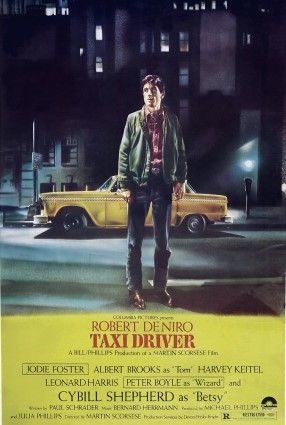 Year Year: 1976 Director: Martin Scorsese Writer(s): Paul Shrader Starring: Robert De Niro, Jodie Foster, Albert Brooks, Harvey Keitel, Leonard Harris, Peter Boyle, and Cybill Shepherd Studio: Columbia Pictures Country of Origin: USA Language: English Running Time: 113 Minutes Aspect Ratio: 1.85:1 Taxi Driver may just be the most grim movie to ever become an iconic part of American Culture. Behind the iconic “you talkin’ to me” line lies what is really a rather depressing portrait of a deeply disturbed and isolated man. In today’s society Travis Bickle may well have become a mass shooter of the Newtown or Aurora variety but who in the culture of 1976 was an attempted political assassin and vigilante. Whatever the final outcome of his madness, the film remains a shockingly believable portrait of the downward spiral that would lead such a man towards violence and of a New York City that was really going to seed at that time. The film takes place in a really hellish urban landscape that seems largely devoid of common decency, just about everyone Bickle encounters seems to be a pimp or an elicit gun salesman or a deranged husband. You can almost see why this would turn someone to want to be a vigilante, but this is no Death Wish and the screenplay is under no delusion that his supposedly righteous violence is done with any higher motivation or that it’s in any way fun to watch. The film isn’t exactly light viewing and if it had been made in any other decade it probably wouldn’t have caught on with the public the way it did, but it remains a powerful character study about a dangerous personality type that society can’t afford to ignore.
|
|
PG Cooper
CS! Silver
 Join Date: Feb 2009
And those who tasted the bite of his sword named him...The DOOM Slayer
Join Date: Feb 2009
And those who tasted the bite of his sword named him...The DOOM Slayer
Posts: 16,647 
Likes: 4,062
Location:
Last Online Nov 22, 2024 22:27:20 GMT -5
|
Post by PG Cooper on Nov 27, 2015 10:55:40 GMT -5
Love Notorious. Glad to see it here.
I think Taxi Driver is the greatest film of all-time.
|
|
IanTheCool
CS! Gold
 Join Date: Jul 2003
Join Date: Jul 2003
Posts: 21,493 
Likes: 2,864
Location:
Last Online Nov 22, 2024 23:08:59 GMT -5
|
Post by IanTheCool on Nov 27, 2015 18:04:21 GMT -5
Love Notorious. Glad to see it here. I think Taxi Driver is the greatest film of all-time. Well you're wrong, its the 49th. |
|
Dracula
CS! Gold
 Join Date: Sep 2002
Join Date: Sep 2002
Posts: 26,102 
Likes: 5,731
Location:
Last Online Nov 22, 2024 23:42:21 GMT -5
|
Post by Dracula on Nov 27, 2015 20:53:14 GMT -5
48. Stagecoach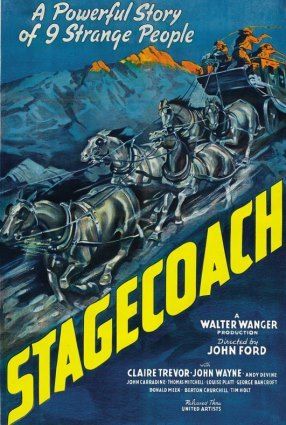 Year Year: 1939 Director: John Ford Writer(s): Dudley Nichols Based on: The short story "The Stage to Lordsburg" by Ernest Haycox Starring: John Wayne, Claire Trevor, Thomas Mitchell, John Carradine, Andy Devine, and George Bancroft Distributor: United Artists Country of Origin: USA Language: English Running Time: 96 Minutes Aspect Ratio: 1.37:1 The western has been a staple of American story telling since… well pretty much since the old west was still the modern west. However, that does not mean that the western was always the staple of American filmmaking that we all assume it was. There were certainly westerns made in the silent era and early 30s, tons of them in fact, but they were almost all hastily made and poorly regarded B-movies… many of them with singing cowboys. With Stagecoach John Ford didn’t necessarily turn the western into a prestige genre but he was able to turn it into an “A” caliber production that wasn’t just meant to be enjoyed by children going to Saturday matinees. The film starts with a really clever high concept about following a group of disparate people united in their mission to cross through dangerous territory in a stagecoach. For the film’s starring role he introduced audiences to a young actor named John Wayne, who would for better or worse become a cultural icon, and he also set the standards for what western action and stunt work was supposed to be like. The film’s influence runs deeper than just the western genre though, just about every aspect of the film is a textbook example of how a Hollywood film should be made and Orson Welles reportedly watched it 40 times while preparing to make Citizen Kane. Really, the more you think about it the more this looks like it may well have been responsible for more hours of derivative work than almost any other film and for good reason.
|
|
Dracula
CS! Gold
 Join Date: Sep 2002
Join Date: Sep 2002
Posts: 26,102 
Likes: 5,731
Location:
Last Online Nov 22, 2024 23:42:21 GMT -5
|
Post by Dracula on Nov 28, 2015 9:59:11 GMT -5
47. Safety Last!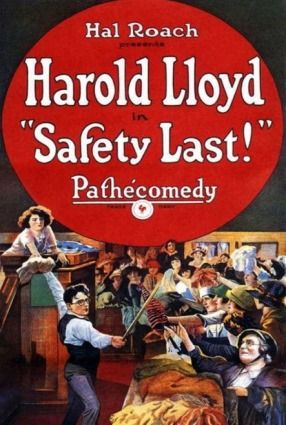 Year Year: 1923 Director: Fred C. Newmeyer and Sam Taylor Writer(s): Hal Roach, Sam Taylor, Tim Whelan, and H. M. Walker Starring: Harold Lloyd, Mildred Davis, Bill Strother, Noah Young, and Westcott Clarke Studio: Hal Roach Studios Country of Origin: USA Language: English Running Time: 73 Minutes Aspect Ratio: 1.37:1 The sight of a bespectacled man hanging from a clock on the side of a building is one of the most iconic images of the silent era, so iconic that a lot of people forget that this image is attached to an entire movie that is just as great. The signature achievement of the great silent comedian Harold Lloyd, Safety Last tells the simple story of a young man going to “the city” in order to make good and create a home for his fiancée. He gets a job at a department story and proceeds to live out a story right out of the pages of a Horatio Alger book but it never really comes off as too corny (or at least not corny in a bad way) simply because Harold Lloyd brings a lot of charm to the table and does a lot to make the audience sympathize with this character. By the time he's finally is climbing that building you fully understand what’s motivating him and it makes you want to see him survive all the more because of it. The mixture of comedy elements and thriller elements in this final sequence are both curious and exhilarating. The slapstick gags that Lloyd comes up with would be awesome on their own, but they’re made all the more exciting because they’re being performed by someone who could fall to his death. He certainly wasn’t the only silent comedian to combine death-defying stunts and comedy, but here he really blended them better than most and the extent to which audiences sympathized with his characters really added an extra dimension.
|
|
Neverending
CS! Platinum
 Join Date: Jul 2003
Join Date: Jul 2003
Posts: 65,773
Likes: 8,648
Location:
Last Online Nov 22, 2024 18:30:10 GMT -5
|
Post by Neverending on Nov 28, 2015 11:02:02 GMT -5
|
|
Dracula
CS! Gold
 Join Date: Sep 2002
Join Date: Sep 2002
Posts: 26,102 
Likes: 5,731
Location:
Last Online Nov 22, 2024 23:42:21 GMT -5
|
Post by Dracula on Nov 28, 2015 18:33:43 GMT -5
46. Grand Illusion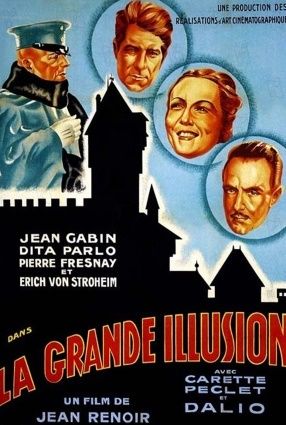 Year Year: 1937 Director: Jean Renoir Writer(s): Jean Renoir and Charles Spaak Starring: Jean Gabin, Dita Parlo, Pierre Fresnay, and Erich von Stroheim Studio: Réalisations d'Art Cinématographique Country of Origin: France Language: French Running Time: 114 Minutes Aspect Ratio: 1.37:1 With his most famous film, The Rules of the Game, Jean Renoir primarily treated the upper class as an object to be ridiculed. With his second most famous film, Grand Illusion, he also critiqued the aristocracy but came at it in a different way. The film, which is set in a World War One prisoner of war camp which in many ways comes to represent greater Europe with its class distinctions and inter-country squabbles. It is perhaps most famous for the cordial relationship between the aristocratic German commandant and a captured French officer who is treated more as a fellow aristocrat than as a sworn enemy. Rather than viewing these upper-class people as leeches on society, here Renoir views them more as tragic figures who adhere to the standards of a breed that’s dying out. He doesn’t exactly glorify them or forgive them for their sins, but he isn’t coming at them with pitchforks either. That’s in part because this isn’t a movie that’s trying to tear down the establishment, rather it is a movie made right before the outbreak of World War II and it’s trying to call for Europeans to see their commonalities and avoid getting into another futile and destructive war. Clearly his plea went unheeded, but the film he left behind is a fascinating document just the same.
|
|
thebtskink
CS! Silver
 Join Date: Jul 2000
It puts the lotion on its skin or else it gets the hose again.
Join Date: Jul 2000
It puts the lotion on its skin or else it gets the hose again.
Posts: 19,462 
Likes: 4,984
Location:
Last Online Nov 22, 2024 15:43:24 GMT -5
|
Post by thebtskink on Nov 28, 2015 18:39:30 GMT -5
Cool that he threw Modern Times in there too. |
|
Dracula
CS! Gold
 Join Date: Sep 2002
Join Date: Sep 2002
Posts: 26,102 
Likes: 5,731
Location:
Last Online Nov 22, 2024 23:42:21 GMT -5
|
Post by Dracula on Nov 29, 2015 11:05:07 GMT -5
45. Pandora's Box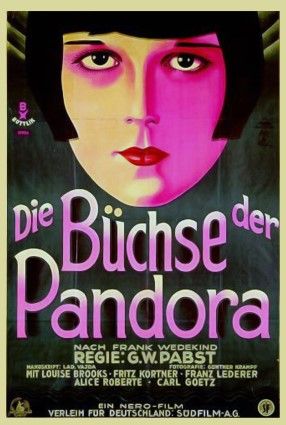 Year Year: 1929 Director: G.W. Pabst Writer(s): G. W. Pabst and Ladislaus Vajda Based on: The plays "Erdgeist" and "Die Büchse der Pandora" by Frank Wedekind Starring: Louise Brooks, Francis Lederer, Carl Goetz, and Alice Roberts Studio: Süd-Film Country of Origin: Germany Language: German Running Time: 133 Minutes Aspect Ratio: 1.37:1 Much of what makes silent filmmaking so compelling is that it works on rhythms that are distinct from the flow of modern films and employ a very specific kind of pantomime. G.W. Pabst’s Pandora’s Box isn’t anything like that. This movie was made during the very twilight of the silent era and does seem to be shot in a very modern way but at the same time I also couldn’t really picture it being a sound film, at least not a sound film in the way that the early “talkies” were. The film feels really adult in a way that the films coming out of Hollywood and a bit more down to Earth than a lot of the films being made by the other European masters of the time. The film is daring in its frank sexuality but also rather mature (if a little retrograde) in its portrait of a fallen woman who more or less ends up in a prison of her own making. Most of all I just really love the setting and feel of the movie. I love the look and feel of Weimar Germany and its roaring 20s decadence and this feels like a film that was made right before all of that started to fall apart. G.W. Pabst might have gotten name-checked in Inglourious Basterds, but in general I don’t think he’s gotten his due by the greater film world and this remains his crowning achievement.
|
|
PG Cooper
CS! Silver
 Join Date: Feb 2009
And those who tasted the bite of his sword named him...The DOOM Slayer
Join Date: Feb 2009
And those who tasted the bite of his sword named him...The DOOM Slayer
Posts: 16,647 
Likes: 4,062
Location:
Last Online Nov 22, 2024 22:27:20 GMT -5
|
Post by PG Cooper on Nov 29, 2015 11:28:26 GMT -5
Cool, another movie I haven't seen.
|
|
Neverending
CS! Platinum
 Join Date: Jul 2003
Join Date: Jul 2003
Posts: 65,773
Likes: 8,648
Location:
Last Online Nov 22, 2024 18:30:10 GMT -5
|
Post by Neverending on Nov 29, 2015 11:32:27 GMT -5
Dracula has a hardon for silent films.
|
|
Dracula
CS! Gold
 Join Date: Sep 2002
Join Date: Sep 2002
Posts: 26,102 
Likes: 5,731
Location:
Last Online Nov 22, 2024 23:42:21 GMT -5
|
Post by Dracula on Nov 29, 2015 11:59:31 GMT -5
Dracula has a hardon for silent films. The silent era comprised roughly 25% of film history, given that I'd say silent cinema is actually rather under represented on the list. |
|
Neverending
CS! Platinum
 Join Date: Jul 2003
Join Date: Jul 2003
Posts: 65,773
Likes: 8,648
Location:
Last Online Nov 22, 2024 18:30:10 GMT -5
|
Post by Neverending on Nov 29, 2015 12:28:45 GMT -5
Silent films represent the rookie and amateur days of filmmaking. Sure, a handful of movies slipped through the cracks and became classics but they don't represent the norm. It's like in television when you get an awesome pilot. It's rare but it happens. I think the reason why comedies from the silent era hold up, and are fondly remembered, is because they only have one goal: be funny. Drama's and the other genre's are a different story because they use visual's to ignite various emotions from the audience - sometimes in a single scene. So now, the technological aspect of filmmaking becomes relevant. How you shoot and edit will have a great influence on the outcome. You can get a great script and a great actor and turn it into shit with the wrong technological decisions. And this is something that early filmmakers had to learn the hard way. So when you say that silent movies are underrepresented, you are being generous.
|
|
thebtskink
CS! Silver
 Join Date: Jul 2000
It puts the lotion on its skin or else it gets the hose again.
Join Date: Jul 2000
It puts the lotion on its skin or else it gets the hose again.
Posts: 19,462 
Likes: 4,984
Location:
Last Online Nov 22, 2024 15:43:24 GMT -5
|
Post by thebtskink on Nov 29, 2015 13:20:04 GMT -5
Lotsa movies added to my to-see list because of Dracula. This thread is rad.
|
|
Dracula
CS! Gold
 Join Date: Sep 2002
Join Date: Sep 2002
Posts: 26,102 
Likes: 5,731
Location:
Last Online Nov 22, 2024 23:42:21 GMT -5
|
Post by Dracula on Nov 29, 2015 17:07:58 GMT -5
44. The Treasure of the Sierra Madre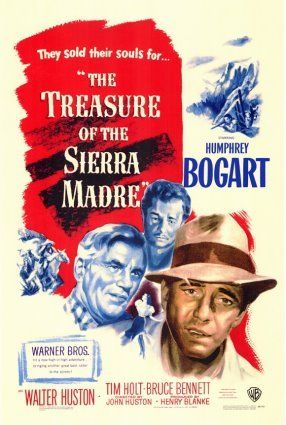 Year Year: 1948 Director: John Huston Writer(s): John Huston Based on: The novel "The Treasure of the Sierra Madre" by B. Traven Starring: Humphrey Bogart, Walter Huston, Tim Holt, and Bruce Bennett Studio: Warner Brothers Country of Origin: USA Language: English Running Time: 126 Minutes Aspect Ratio: 1.37:1 John Huston was a director who emerged at a rather unusual time for the studio system. He was of a younger generation than the than the likes of Frank Capra but he was also a bit too old to have been at the forefront of the boundary pushing cinema that emerged in the late fifties. He was a consummate journeyman who had a very long and productive career but he’ll probably forever be most remembered for the rapport he formed with Humphrey Bogart. While Huston did not direct Bogart in his most famous film, he did direct most of the other performances that Bogart is most fondly remembered for including the amazing work that he did in The Treasure of the Sierra Madre. Bogart always had a certain darkness to him and was never a straightforward screen hero but in this film he was pretty much a straight-up villain and a somewhat weak and pathetic one at that. The film is a parable about the dangers of greed set against a rip-roaring adventure story that was (uncharacteristically for the time) filmed on location in Mexico. The film ends on a sort of cosmic joke on the characters and really that’s the only way it could end. It’s one of the darkest movies to come out of the “golden age” studio system and the fact that it still holds up as a fun adventure really says a lot about it.
|
|
Neverending
CS! Platinum
 Join Date: Jul 2003
Join Date: Jul 2003
Posts: 65,773
Likes: 8,648
Location:
Last Online Nov 22, 2024 18:30:10 GMT -5
|
Post by Neverending on Nov 29, 2015 17:33:16 GMT -5
That's one of my favorite movies from the 1940's.
|
|
thebtskink
CS! Silver
 Join Date: Jul 2000
It puts the lotion on its skin or else it gets the hose again.
Join Date: Jul 2000
It puts the lotion on its skin or else it gets the hose again.
Posts: 19,462 
Likes: 4,984
Location:
Last Online Nov 22, 2024 15:43:24 GMT -5
|
Post by thebtskink on Nov 29, 2015 17:37:42 GMT -5
"We don't need no stinkin' badges"
|
|
Dracula
CS! Gold
 Join Date: Sep 2002
Join Date: Sep 2002
Posts: 26,102 
Likes: 5,731
Location:
Last Online Nov 22, 2024 23:42:21 GMT -5
|
Post by Dracula on Nov 30, 2015 7:30:59 GMT -5
43. La Dolce Vita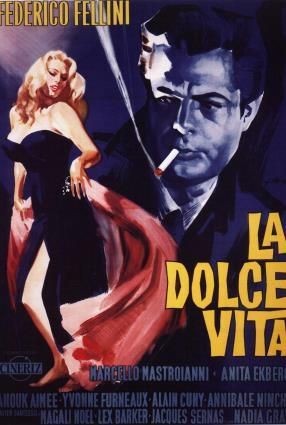 Year Year: 1960 Director: Federico Fellini Writer(s): Federico Fellini, Ennio Flaiano, Tullio Pinelli, Brunello Rondi, and Pier Paolo Pasolini Starring: Marcello Mastroianni, Anita Ekberg, Anouk Aimée, Yvonne Furneaux, Magali Noël, Alain Cuny, and Nadia Gray Studio: Cineriz Country of Origin: Italy Language: Italian Running Time: 174 Minutes Aspect Ratio: 2.35:1 Federico Fellini’s La Dolce Vita may or may not be the greatest film of the 1960s arthouse golden age but it is almost certainly the coolest. The film is a wonderfully delicious portrait of post-war European decadence and its inherent stylishness seems both highly specific to a certain time and place and absolutely timeless at the same time. In fact one could say that this particular film is still the gold standard that the rich and the stylish are trying to live up to and you can tell that the film has had untold influence over celebrity culture. It’s even the direct source of the word “paparazzi.” That the film would become such an aspirational model is perhaps ironic because the film is actually deeply ambivalent if not openly hostile towards the society that it depicts even while it revels in its inherent glamour. When the film opened in 1960 it was an instant sensation, it won the Palme D’or and became a huge box office hit despite being condemned by the Catholic Church and also made Fellini a titan of world cinema. It was definitely Fellini’s biggest hit at the time even if it’s something of an aberration in his career in that it’s carnival elements seem less like a surreal vision than a slightly exaggerated version of reality.
|
|
PG Cooper
CS! Silver
 Join Date: Feb 2009
And those who tasted the bite of his sword named him...The DOOM Slayer
Join Date: Feb 2009
And those who tasted the bite of his sword named him...The DOOM Slayer
Posts: 16,647 
Likes: 4,062
Location:
Last Online Nov 22, 2024 22:27:20 GMT -5
|
Post by PG Cooper on Nov 30, 2015 11:03:03 GMT -5
Two great films.
|
|
Dracula
CS! Gold
 Join Date: Sep 2002
Join Date: Sep 2002
Posts: 26,102 
Likes: 5,731
Location:
Last Online Nov 22, 2024 23:42:21 GMT -5
|
Post by Dracula on Nov 30, 2015 18:54:41 GMT -5
42. Jaws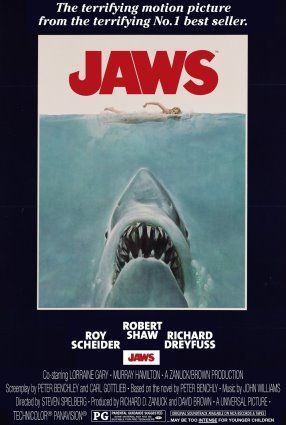 Year Year: 1975 Director: Steven Spielberg Writer(s): Peter Benchley and Carl Gottlieb Starring: Roy Scheider, Robert Shaw, Richard Dreyfuss, Lorraine Gary, and Murray Hamilton Based on: The novel "Jaws" by Peter Benchley Studio: Universal Country of Origin: USA Language: English Running Time: 124 Minutes Aspect Ratio: 2.35:1 Steven Spielberg’s breakthrough film Jaws holds a slightly infamous place in film history because it’s largely credited for the creation of the summer blockbuster as a Hollywood institution that would soon kill off the “New Hollywood” movement and usher in an era of crass commercialism that lives on to this day. Whatever responsibility the film has for this state of affairs, it certainly isn’t Spielberg’s fault that he made a movie that was so damn entertaining and effective that it made millions upon millions of people want to see it. The film is frequently classified as a horror film because of its highly suspenseful moments accompanied by John Williams’ minimalist score. However, much of the film takes place in broad daylight and when the heroes are going after the shark at the end it almost starts to feel like a high seas adventure movie. The film is a beautiful example of how a little bit of ambition and a lot of skill can elevate pretty much anything because at its core this is a very dumb story based on a trashy book about a monster eating people, but it doesn’t feel like that at all because Spielberg makes all the right decisions to keep the film on the right side of tasteful. The film’s likable cast, well defined characters, and thrilling set pieces all combine perfectly to create a creature feature like no other.
|
|
IanTheCool
CS! Gold
 Join Date: Jul 2003
Join Date: Jul 2003
Posts: 21,493 
Likes: 2,864
Location:
Last Online Nov 22, 2024 23:08:59 GMT -5
|
Post by IanTheCool on Nov 30, 2015 20:35:21 GMT -5
Good.
|
|
Dracula
CS! Gold
 Join Date: Sep 2002
Join Date: Sep 2002
Posts: 26,102 
Likes: 5,731
Location:
Last Online Nov 22, 2024 23:42:21 GMT -5
|
Post by Dracula on Dec 1, 2015 7:26:21 GMT -5
41. Psycho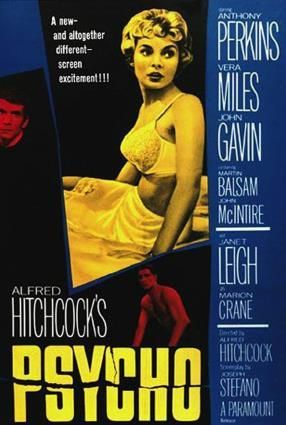 Year Year: 1960 Director: Alfred Hitchcock Writer(s): Joseph Stefano Based on: The novel "Psycho" by Robert Bloch Starring: Janet Leigh, Anthony Perkins, Vera Miles, John Gavin, Martin Balsam, and John McIntire Studio: Paramount Country of Origin: USA Language: English Running Time: 109 Minutes Aspect Ratio: 1.85:1 Spoiler Warning, I guess. People will always debate what Alfred Hitchcock’s best film is, but it’s pretty clear that within popular culture his most film is almost certainly Psycho, which is odd because while it is Hitchcockian to its core is also differs from his other films in certain key ways. The film is clearly a lot cheaper than the technicolor extravaganzas that he was making at the time and this was intentional. He used the production crew behind his TV series rather than the Hollywood talent he’d normally use because he wanted to give the film almost a sort of sleazey B-movie aura. The film also doesn’t barter in the usual “wrong man formula” and has a much less sympathetic protagonist than most of his films. Janet Leigh’s character starts off the movie in bed with a man (which was eyebrow raising in 1960) and is shortly thereafter stealing money from her boss. At this point audiences are expecting a sort of noir-tinged crime film to play out when out of nowhere the film’s star is graphically stabbed to death by what appears to be an old woman. The extent to which this must have been shocking in 1960 probably can’t be understated. A mid-film plot twist of this gravity was almost unprecedented and the sex and violence up to this point must have really seemed transgressive at the time. Honestly, I’m not sure how he got away with it, but I’m glad he did. Some people think that this invented the slasher movie (not entirely true, it doesn’t follow that formula) and its famous score and the meticulousness of its editing are rightly famous.
|
|